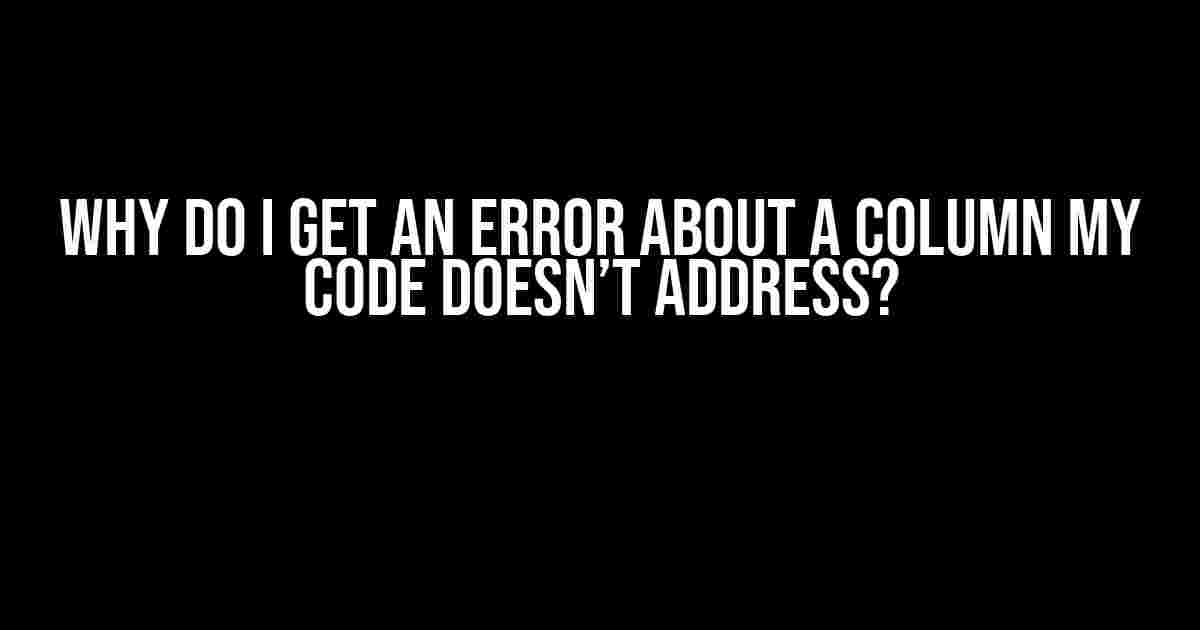Have you ever encountered an error message that left you scratching your head, wondering why your code is complaining about a column you’re not even using? You’re not alone! This frustrating phenomenon has plagued developers for ages, and today, we’re going to get to the bottom of it.
The Mysterious Column Error
You’ve written a seemingly flawless script, executed it with confidence, and… BAM! The error message slaps you in the face, leaving you confused and annoyed. It might look something like this:
ERROR: column "column_name" does not exist LINE 1: SELECT * FROM table_name
“Wait, what?!” you exclaim. “I didn’t even mention ‘column_name’ in my code!” But, alas, the error persists.
Common Culprits Behind the Column Conundrum
Before we dive into the solutions, let’s identify the usual suspects behind this error:
- Invisible Columns**: In some databases, columns can be “hidden” or not explicitly listed in the table definition. These columns might still be present in the table, causing the error.
- Derived Tables**: When using derived tables (subqueries in the FROM clause), the columnist error can occur if the subquery references a column not present in the main query.
- Views**: Views can sometimes mask the underlying table structure, leading to columnist errors when the view doesn’t include the referenced column.
- Joins**: Incorrect or incomplete join statements can cause the error, especially when joining multiple tables with similar column names.
Investigating the Issue
Now that we’ve identified the potential culprits, let’s try to diagnose the problem step-by-step:
- Check the SQL Statement**: Review your SQL code line by line, paying attention to any columns mentioned explicitly or implicitly. Look for any typos, incorrect table or column names, or missing keywords (e.g., AS).
- Verify Table Structure**: Use the DESCRIBE or DESC command to inspect the table definition and identify any hidden or unexpected columns.
- Analyze Derived Tables and Views**: If using derived tables or views, examine the subquery or view definition to ensure all columns are properly defined and referenced.
- Re-examine Joins**: Double-check join statements, paying attention to table aliases, join types, and column names.
Resolving the Error
Now that we’ve investigated the issue, let’s tackle the solutions:
Solution 1: Correct Column References
If you’ve identified a typo or incorrect column reference, simply correct the SQL statement. For example:
-- Incorrect: SELECT * FROM table_name WHERE colum_name = 'value'; -- Correct: SELECT * FROM table_name WHERE column_name = 'value';
Solution 2: Use Aliases or Fully Qualify Column Names
In cases where column names conflict between tables, use aliases or fully qualify the column names to avoid ambiguity:
SELECT t1.column_name, t2.column_name FROM table_name t1 JOIN other_table_name t2 ON t1.id = t2.id;
Solution 3: Define Columns in Derived Tables and Views
When using derived tables or views, ensure all columns are properly defined and referenced:
CREATE VIEW my_view AS SELECT column1, column2, column3 FROM table_name; SELECT * FROM my_view;
Solution 4: Adjust Join Statements
Re-examine and adjust join statements to ensure correct table aliases and column references:
SELECT * FROM table_name t1 LEFT JOIN other_table_name t2 ON t1.id = t2.id WHERE t1.column_name = 'value';
Conclusion
The mysterious column error can be frustrating, but by following these steps and solutions, you’ll be well-equipped to tackle the issue head-on. Remember to:
- Verify your SQL statement for errors
- Inspect the table structure and derived tables/views
- Adjust join statements and column references as needed
With patience and persistence, you’ll resolve the error and get back to coding with confidence. Happy debugging!
| Common Error Causes | Diagnostic Steps | Solutions |
|---|---|---|
| Invisible Columns, Derived Tables, Views, Joins | Check SQL Statement, Verify Table Structure, Analyze Derived Tables/Views, Re-examine Joins | Correct Column References, Use Aliases/Fully Qualify Column Names, Define Columns in Derived Tables/Views, Adjust Join Statements |
Frequently Asked Question
Are you puzzled by those pesky column errors that seem to come out of nowhere? You’re not alone! Here are some possible explanations and solutions to get you back on track.
Why do I get an error about a column my code doesn’t address?
It’s possible that another part of your code, a trigger, or even a third-party library is referencing the column that’s causing the error. Take a closer look at your code, and if you’re still stumped, try debugging tools or logging to identify the culprit.
Could it be a typo or a column rename issue?
Absolutely! A single typo or a column rename can cause a world of trouble. Double-check your column names, and make sure they match exactly (including case sensitivity) in your code and database schema.
Is it possible that the error is coming from a different query or stored procedure?
Yes, it’s definitely possible. If you’re running multiple queries or stored procedures, one of them might be referencing the problematic column. Try to isolate the issue by commenting out or removing individual queries to identify the source of the error.
Could the issue be related to a schema change or migration?
That’s a great point! If you’ve recently made changes to your database schema or migrated to a new database, it’s possible that the error is related to a column that no longer exists or has been renamed. Review your schema changes and migration scripts to ensure everything is in sync.
What if I’ve checked everything and still can’t find the issue?
Don’t give up! When all else fails, try rebuilding your project, updating your dependencies, or even seeking help from a colleague or online community. Sometimes, a fresh set of eyes or a different perspective can help you catch that pesky error.






